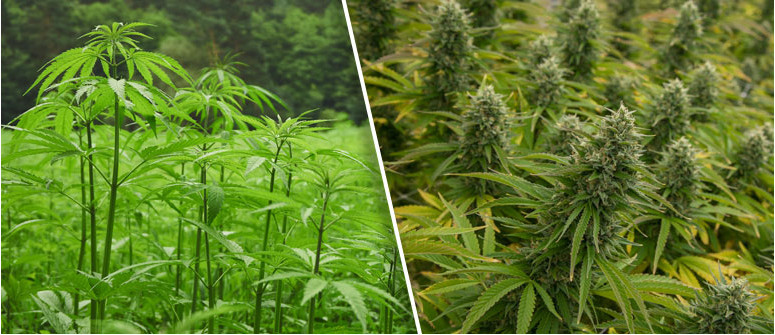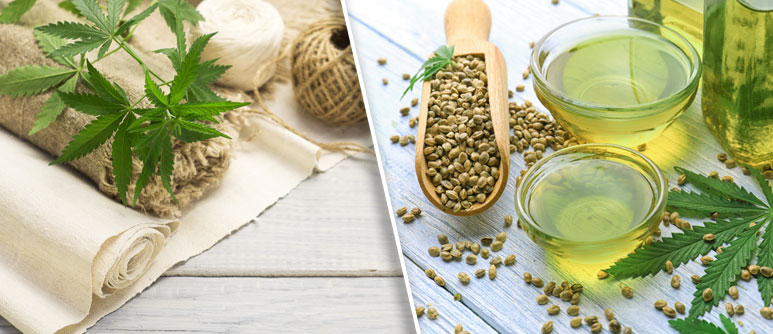What is the difference between hemp and marijuana?

If you are able to smoke it and it actually gets you high, then technically it is called Marijuana. Otherwise, we call it Hemp, or industrial Hemp.
You don’t need to be a rocket scientist or a botanist to quickly understand the fundamental differences between Hemp and Marijuana. In a nutshell, if you are able to smoke it and it actually gets you high, then technically it is called Marijuana. Otherwise, we call it Hemp, or industrial Hemp. Period.
Seriously, that is the only difference. They both come from the genus Cannabis and species Sativa, therefore scientifically the same thing. Legally though, they are quite different.
Think of it like comparing yourself to your brother or sister (if you have one). You both come from the same family, but each has slightly different characteristics. You might be taller, have blonde hair and blue eyes… while your sibling is shorter and presents a dark brown hue. Nonetheless, you share an almost exact same genetic make-up to each other. Your genotype is almost identical. What differs between you is the environmental expression of these genes, the phenotypes.
In the case of Cannabis, it all boils down to the amount of THC produced by that specific strain. Marijuana is a plant that presents a phenotype for high THC production while Hemp is a plant that produces an extremely low THC content.
So where do we draw the line? Each country will have its own legal statute, but roughly speaking, Cannabis will require a level below 0,3% THC to be considered Hemp. Essentially, it is the psychoactive property of each plant that classifies it. If you can’t get high, then it’s not Marijuana. As a reference point, any prized recreational Cannabis strain has THC content upwards of 20%.
HEMP TO POWER THE FUTURE OF MANKIND

Hemp is produced for its total mass in weight, while Marijuana is mainly produced for its female flowers – or bud. Hemp plants are harvested and processed to harness fibers, seeds, and oils. Thousands of industries depend on hemp, ranging from textile, food, cosmetics, and fuel, as well as many others.
In fact, according to Dr. David Mitlin, a professor at New York’s Clarkson University, the waste product of hemp outperforms graphene, costing a fraction of the price to produce it.[1] And yes, I did say “the waste product”. Graphene is one of the lightest, most conductive and strongest carbon atom fibers known to man. This positions Cannabis as one of the most promising technologies for the production of supercapacitors in the new era of high energy-storing batteries.[2] Imagine that. Your mind, body, soul, laptop, phone and car… all running on cannabis!
But Hemp goes back a long, long way… Cannabis is considered to be one of the first domesticated plant species cultivated by man, ranging back almost 10,000 years. The weaving of Hemp fibers into fabrics is a known archaeological human activity. Sails for boats, ropes, paper and clothes were typically made from Cannabis fibers. Up to 90% of all paper produced until the 1900’s was made from Hemp…. Or was it Marijuana? Guess we will never know.
Hemp strains are favored for their total weight, while Marijuana strains solely for their female flowers, but nothing at the moment is able to distinguish the biomass potential between the two. Weight-by-weight, their biomass potential is identical. Hemp and Marijuana are the same; the only difference resides in our relationship to it.
With the advent of the legalization of medical and recreational Marijuana, we can expect large-scale commercial operations to maximize their earnings by selling their “waste” product to the Hemp industry. And this would only be a phenomenal thing. Cannabis truly is a wondrous plant, with an astounding number of different uses. In an age where renewable energies are a priority, to deny a serious discussion on Cannabis’s contribution to our environmental crisis seems almost criminal.
Cannabis can provide concrete solutions to the three main pillars of societal advancement – health, industry, and agriculture. The faster we collectively embrace the facts, the sooner we can start healing our planet. According to the World Wild Life Organization, 48 football fields worth of trees are lost every minute.[3] We have got to change our mindsets fast! Our planet depends on it.
Who knows, maybe one day we will be driving cars made out of Cannabis, and maybe even fueled by Cannabis!
WHAT HAPPENED TO HEMP?
Despite not having any relevant psychoactive properties, Hemp is still illegal in many countries. It is widely accepted that this is due to the works of Harry J. Anslinger, acting as the first commissioner of the U.S. Treasury Department’s Federal Bureau of Narcotics. In 1937 Congress approved the Marijuana Tax Act.
At the time there was no distinction between Hemp and Marijuana, they were considered one and the same. It was only until 1964 when Prof. Raphael Mechoulam, professor of Medical Chemistry at the Hebrew University of Jerusalem, isolated and named the THC molecule, that we truly understood the difference. Only from then on did we know that it was actually
D9-tetrahydrocannabinol the main compound responsible for the psycho-activeness of Cannabis.
Back to 1937 America, the implications of the Marijuana Tax Act made it virtually impossible for farmers across the continent to pursue with their generation’s old activities. Conspiracy theorists claim the “cotton cartel” played an important role in the unfolding of these events, but any concrete evidence has been buried by time.
Despite that, the fact is that from then on Hemp literally disappeared from mainstream industry, leaving a huge gap for the exploitation of the next best thing found in nature – cotton and wood.
Population growth fueled increased agricultural and industrial demands, and this has led to the devastating deforestation phenomena we are witnessing. Cannabis can reverse this trend if we chose to accept scientific evidence.
HEMP IS AS IMPORTANT TO MANKIND AS MARIJUANA
The fundamental difference between Hemp and Marijuana is, therefore, us, the human being. It is we that have CB-1 receptors in our bodies. CB-1 receptors are part of our endocannabinoid system, which by chance of nature (or not – but that’s whole a different debate) just happens to be activated by the THC found in cannabis. And THC has been made illegal by humans.
Hemp and Marijuana are one and the same, just like apples are apples, and oranges are oranges. Just different strains for different folk.
Cannabis has an astonishing potential for medicine as well as possibly being a key player in the re-balancing of the world’s resources.
We are on a fast track to depleting the world’s natural resources.
According to a 1916 USDA study, it would take 5,4 acres of wood to produce 1 ton of fiber per year, while for the same amount, only 1.33 acres of hemp would suffice.[4] That is data from 101 years ago! Imagine what is achievable with today’s technological advancement with modern greenhouses.
According to the WWF, 17% of the Amazon forest has been lost to cattle ranching and agriculture. 15% of all greenhouse effects are a direct consequence of this. And this, in the last 50 years alone.
The case stands strong for either and both. Be it Hemp or Marijuana, we must rapidly accept it is a plant that hosts tremendous benefits to mankind.
- ^ BBC, Hemp fibres better than graphene, retrieved January-30-2019
Link - ^ ACS Publications, Interconnected Carbon Nanosheets Derived from Hemp for Ultrafast Supercapacitors with High Energy, retrieved January-30-2019
Link - ^ Worldwildlife, Deforestation, retrieved January-30-2019
Link - ^ Hempology, Bulletin of the U.S. Department of Agriculture, retrieved January-30-2019
Link
.jpg)
.jpg)

.jpg)
